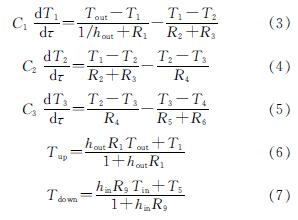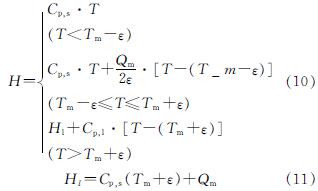基金项目:国家自然科学基金项目(51678263)
第一作者:徐 侃(1996-),男,助理工程师,主要从事节能围护结构研究工作. E-mail: 714200852@qq.com 通信作者:徐新华(1972-),男,教授,博士生导师,主要从事新型围护结构主动被动隔热保温理论与技术研究工作. E-mail: bexhxu@hust.edu.cn
(Department of Building Environment & Energy Engineering, Huazhong University of Science & Technology, Wuhan 430074, China)
pipe-embedded phase change material slab; phase change energy storage for all-day heating; simplified heat transfer model; heat transfer analysis
DOI: 10.15986/j.1006-7930.2021.06.014
2018年全国建筑全过程碳排放总量占全国碳排放的比重为42%,能耗总量占全国能源消费总量比重为36%[1-2].减少建筑能耗的一个重要手段就是利用绿色清洁能源如太阳能、地热能等来减少碳排放.而这些清洁能源的利用有很多不同的方式,如传统的使太阳照射墙体,然后墙体向室内传热; 或利用太阳辐射加热空气并将其送入室内来取暖[3-4].太阳辐射是间歇式的,还不稳定.如何有效利用白天的太阳辐射并使得这些能量能在全天都能得到应用是一个很值得研究的问题.
相变储能技术是克服太阳辐射间歇性和不稳定性的一个重要手段[5].相变材料在很窄的温度范围内能吸收或释放大量的相变潜热,使得房间温度变化小、热舒适性好,适合在建筑中使用[6-7].相变材料与外墙结合是一种常见的应用方式,白天融化吸收墙体热量,夜晚凝固缓慢放出热量,补偿室内热损失[8].添加了相变材料层的复合屋顶也有一定的蓄热能力,能减少室内能量损失,提升室内热舒适度[9].
直接由太阳照射墙体来实现建筑被动采暖效率较低.在围护结构中嵌入管道通入高温冷水或低温热水,可以大大减少墙体的内外传热,减少建筑负荷,同时也可利用低品位能源提高建筑能效,如内嵌管墙[10]、内嵌管窗[11]等.也有采用室内排风来减少建筑围护结构向室内传热的方式减少室内负荷[12].太阳能集热器-内嵌管式相变顶板系统[13]的内嵌管式相变顶板贴附于屋顶内表面,该系统可以通过管内热水在相变板内部实现加热,同时利用与管壁面的大接触面积特点实现大量的热量传递,提高蓄热速度.相变板在蓄热过程中可以不断向室内散热,在夜间还可以不断地向室内放热达到供暖的效果.这一系统充分克服太阳能间歇性,实现连续供暖.
由于相变潜热的存在,相变材料的热物性参数与材料的温度有关,传热特性存在明显的动态特性.目前对于相变材料的传热,多采用数值模型进行模拟,模型复杂,计算成本较大,且难以与建筑系统模型集成[14].文献[15]对相变平板提出了一种可变热容热阻模型,并通过实验对模型进行了验证,该模型准确性高但需要对模型参数进行辨识,且参数辨识通常要求有深厚的理论基础知识,需要根据数值模拟的结果在时间域内或者频域内对参数进行辨识,对于工程人员来说是很难做到这一点的.对于内嵌管式相变顶板,其模型结构为非规则结构,其传热模型需要进一步研究.本文对太阳能集热器-内嵌管式相变顶板系统进行研究,并针对内嵌管式相变顶板系统提出了一种简化的RC模型,根据其几何配置直接对简化传热模型进行参数配置.根据这一简化模型可以进行该相变板的热特性计算与分析.进一步以某内嵌管式相变顶板为例建立其简化模型,并以该结构的数值模拟结果验证该方法的可行性及该模型的准确性.
整个太阳能集热器-内嵌管式相变顶板系统如图1所示,包括太阳能集热器、普通屋面、相变板和载热介质循环组件.载热工质循环组件由供水管、内嵌管、回流管和泵体组成,管内充注水作为载热工质.相变板内衬于普通屋顶内侧,相变板内嵌入内嵌管,以加热相变板,从而实现隔热以及对室内环境加热的功效.在白天,该系统由太阳能集热器采集太阳辐射能,被加热的水循环送入相变板的内嵌管中,相变板会通过相变材料有较高相变潜热的性质储存该热量.该热量在白天不断释放,同时蓄存的热量也在夜晚继续释放给室内,从而起到保温效果,能减少室内温度波动,提升室内的舒适性.
图1 太阳能集热器-内嵌管式相变顶板系统示意图
Fig.1 The schematic diagram of the system integrating solar collector with pipe-embedded phase change material(PCM)slab roof
本文在常规屋顶下表面内贴内嵌管式相变顶板(称为内嵌管式相变顶板屋面).整个内嵌管式相变顶板屋面示意图如图2(a)所示.根据标准[16]选择该屋顶的结构参数,如表1所示,其中普通屋顶的总传热系数为0.94 W/m2·℃,热惰性指标为3.55,满足标准中屋顶总传热系数≤1.0,热惰性参数≥3.0的设计要求.其中相变板厚度为40 mm,选用的相变材料为一种复合石蜡[17],相变温度为28~30 ℃,相变潜热为221.5 kJ/kg.相变板内部设有直径为15 mm的铜管,管间距为100 mm.
图2(b)为内嵌管式相变顶板简化模型示意图.内嵌管式相变顶板的传热简化为垂直方向上的一维问题.将相变板从内嵌管中心的平面上分为上下两个部分,上部分传热采用一个热容两个热阻模型(即2R1C)进行描述,下部分传热也采用2R1C模型进行描述,内嵌管式相变顶板温度节点的热平衡方程式如式(1)、式(2)所示.温度节点热容随着温度的变化而变化.当节点温度小于28 ℃及大于30 ℃时,相变材料的比热为2 000 J/kg·℃,当节点温度介于28 ℃与30 ℃之间时,相变材料处于相变区,其有效比热可取相变潜热与相变温差的比值与非相变区比热之和,即112 750 J/kg·℃.

式中,T4、T5为温度节点,Tmid为相变板上表面温度,Tpipe为内嵌管壁温度,Tdown为相变板下表面温度,τ为时间变量,R6、R7为上部分相变材料的等效热阻,R8、R9为下部分相变材料的等效热阻,C4为上部分相变材料的等效热容,C5为下部分相变材料的等效热容.C4随节点温度T4变化,C5随节点温度T5变化.
对于常规屋面层(图2(a)),膨胀珍珠岩层及上层的水泥砂浆层简化为2R1C模型,传热方程如式(3)所示.钢筋混凝土层与下层的水泥砂浆层简化为3R2C模型,传热方程如式(4)、式(5)所示.这些R,C参数不同于相变板的模型参数,建筑材料一旦确定,这些参数就随之确定了.根据基本的热平衡可知,屋顶上表面的温度如式(6)所示,相变板下表面的温度如式(7)所示,管道壁面温度如式(8)所示.考虑到相变板内贴于屋顶内表面,且考虑相变板与空气的界面边界及与内嵌管内水流温度边界,整个内嵌管式相变顶板屋面的简化模型如图3所示.已知水温、室外空气温度、室内空气温度,联立方程式(1)~(8),即可求取各温度节点温度.

 (8)
(8)
式中,Tup、Tdown分别为室外空气综合温度及室内温度,T1、T2、T3、T4、T5分别为各温度节点的温度,Tpipe、Twater分别为内嵌管壁及管内水流温度,℃; hout、hin、hp,w分别为屋顶上表面、相变板下表面以及管内工质的对流换热系数,W/(m2·℃); k表示单位宽度相变板截面上内嵌管的个数.
根据本文提出的内嵌管式相变顶板屋面简化模型,在TRNSYS软件中建立该内嵌管式相变顶板屋面组件,并搭建模拟平台,如图4所示,采用武汉地区典型日室外空气温度条件作为输入,可由内嵌管式相变顶板屋面组件得到该屋面内外表面温度及热流等传热特征.
为验证简化模型的准确性,利用计算流体软件FLUENT建立该内嵌管式相变顶板屋面的数值模型,模拟该结构的传热特性并作为基准来验证简化模型的准确性.相变材料相变过程及传热过程复杂,为方便求解进行以下假设:墙体材料均匀且各向同性; 墙体各层材料紧密接触,忽略接触热阻; 相变材料融化时忽略对流传热的影响和体积变化[18].对于相变传热问题选用Solidification/Melting模型进行求解,该模型采用焓法模型,如式(9)~(11)所示.


式中:T为相变材料温度,Tm为相变材料的相变温度区间的中心温度,ε为相变半径,即相变温度区间的一半,℃; ρ为密度,kg/m3; λ为导热系数,W/(m·℃); Cp,s、Cp,l为相变材料在固相、液相时的比热容,J/(kg·℃); Qm为相变材料的潜热,J; H为相变材料的焓,Hl为相变材料液相饱和焓,J.
在ICEM软件中建立该内嵌管式相变顶板屋面的模型网格,再将其导入FLUENT软件中使用周期性正弦温度边界对模型条件进行网格无关性验证与时间独立性验证,确定网格数量为8万个,同时确定模拟时间步长为10 s,相变模型的迭代收敛精度为10-6,建立上述内嵌管式相变顶板屋面的数值模型进行模拟.
冬季采暖一般采用采暖室外计算温度进行墙体稳态传热计算.本研究考虑包括室外太阳辐射等的动态边界的影响,采用屋顶外表面的空气综合温度进行屋顶动态传热计算.为了验证该简化模型的准确性,采用武汉地区(夏热冬冷地区)设计日的室外空气干球温度及太阳辐射进行计算得到室外空气综合温度作为屋顶外表面边界条件进行计算,如图5所示.计算室外空气综合温度时,外表面对流换热系数为22.7 W/(m2·℃); 室内空气温度为18 ℃,该温度作为计算该屋面结构传热的一个边界条件.内表面对流换热系数为8.3 W/(m2·℃).
对于内嵌管内的水流,对流换热系数可由式(12)计算,式中Nu为努塞尔数,Re为雷诺数,Pr为普朗特数.取管内水流速为0.5 m/s,对流换热系数hp,w经计算为2 660 W/(m2·℃).内嵌管内水流在8~18时通热水,管壁为对流边界条件,水温为40 ℃,其余时间水流静止.
Nu=hD/λ=0.023Re0.8Pr0.3(12)
FLUENT软件不能直接设置非规则周期性变化的边界条件,需要通过编辑UDF文件将外界温度等边界条件导入软件以实现边界条件的周期性变化.屋面上表面、相变顶板下表面及内嵌管内水温均为第三类边界条件,考虑管道布置的对称性,图2(a)左右两侧边界条件设置为绝热.模拟时长以24 h为周期进行多天的模拟,直至模拟达到准稳态,即温度与热流变化与前一天的一致.
采用TRNSYS模拟软件实现简化模型的计算,并将所得结果与FLUENT模拟结果进行比较.TRNSYS软件读取边界条件时会根据模拟的时间步长对边界温度条件进行自动插值.图6比较了一天24 h数值模拟与简化模型预测的上表面热流与温度,温度差值平均值为0.55 ℃,两种模拟软件插值方式不同,数值模拟的上表面温度在一段时间比室外空气综合温度略高.热流为正值表示室外空气综合温度高于屋面上表面温度,屋面从外界吸热,热流值为负值表示室外空气温度低于屋面上表面温度,屋面向外界放热,9点时,室外空气综合温度上升速度最快,由于屋顶具有蓄热性,此时室外空气综合温度为3.1 ℃,屋面温度为1.5 ℃,温差达到了1.6 ℃,屋面从外界吸热达到了最大值; 17点时,室外空气综合温度下降速度最快,同样由于屋顶的蓄热性,此时室外空气综合温度为4.6 ℃,屋面温度为6.4 ℃,温差达到了1.9 ℃,屋面向外界放热达到了最大值.数值模型一天24 h内上表面的总传热量为0.780 MJ,简化模型预测的上表面总传热量为0.760 MJ,相对误差大小为2.6%,两个模型计算的总传热量基本一致.
图7比较了一天内数值模拟与简化模型预测的管壁温度及热流的差异.温度差值平均值为0.08 ℃,简化模型预测的管壁温度值与数值模拟的结果基本一致.热流值为正值表示管壁温度低于水温,管内热水向管壁放热,此时相变材料吸收由太阳能集热器转移到水中的太阳辐射能.24 h内,数值模拟的管内流体向管壁传递的总热量为11.338 MJ,简化模型预测的管内流体向管壁的总传热量为11.785 MJ,相对误差为4.0%.最大差异出现在8点,此时管内热水流动,工况边界发生变化(水开始流动).其余时间内简化模型预测与数值模拟的结果一致.
图8为内嵌管式相变顶板在一天24 h内向室内空气传递的逐时热量及下表面的逐时温度.温度差值平均值为0.45 ℃,简化模型预测的下表面温度与数值模拟的结果基本一致.相变顶板下表面全天向室内空气放热,热流最小值为88.9 W/m2,最大值为170.5 W/m2.数值模拟一天24 h内的总传热量10.751 MJ,简化模型预测的总热量为11.137 MJ,相对误差为3.6%.结果表明简化模型能很好地对内嵌管式相变顶板的热特性进行预测.
图9给出了内嵌管式相变顶板内相变材料一天的液相率变化.从8点开始,40 ℃的热水开始输送,相变材料的液化率迅速上升,在白天8~18时供热水期间均处于完全液化的状态.从21时开始,相变材料开始凝固,一直到早上8时,相变顶板内的相变材料温度均处于相变区间内,这个时间段内相变材料能够向室内缓慢释放相变潜热,起到了保温供暖效果.
表2为单位面积相变顶板内表面所对应的该内嵌管式相变顶板及屋面全天换热量统计,可以看到,一天内该内嵌管式相变顶板系统各表面总换热量基本满足热量平衡.
简化模型能够有效地提高计算效率.在同一台计算机(i7处理器、8核)上进行计算,CFD数值模型模拟24 h的传热过程需要2 h,在TRNSYS软件中计算本文提出RC简化模型的传热过程仅需20 s,计算时间大大缩小,计算时间不到数值模拟的1%.在满足计算精度的前提下,RC热容热阻简化模型能够有效地降低计算时间,大大提高计算效率.
本文提出了内嵌管式相变顶板的二阶可变热容热阻简化模型,进一步采用CFD模拟软件建立该内嵌管式相变顶板屋面的数值模型用于验证简化模型的可行性,得到了以下结论:
(1)该简化模型仅根据内嵌管式相变顶板的几何配置就可直接得到模型参数,无需进行参数辨识,计算成本低;
(2)将简化模型的计算结果与数值模拟的屋面上表面、管壁、相变顶板下表面的温度及热流的结果进行比较,结果表明提出的简化模型可以对内嵌式相变顶板的热特性进行准确预测.所预测的热流结果与数值模型基本一致,表面24 h总热量的相对误差小于5%;
(3)该简化模型的计算效率远高于数值模型,其计算所花费的时间仅为数值模拟的1%.